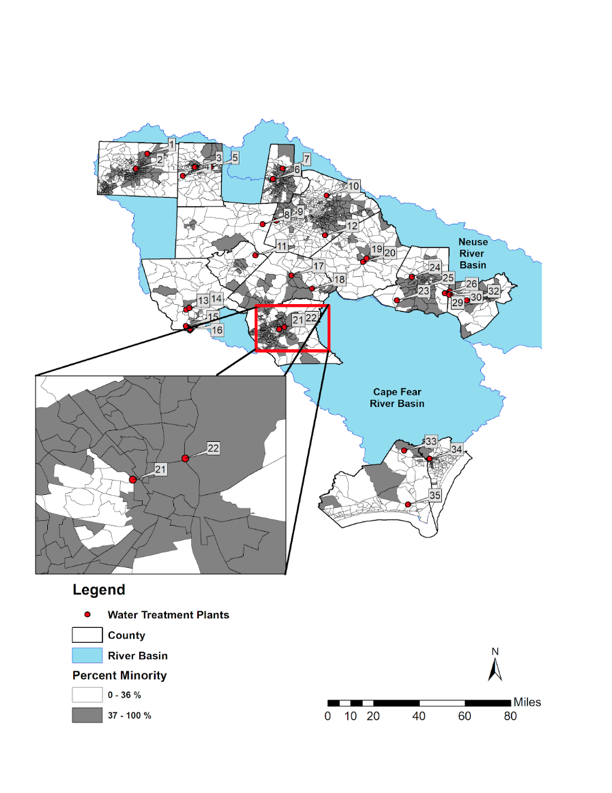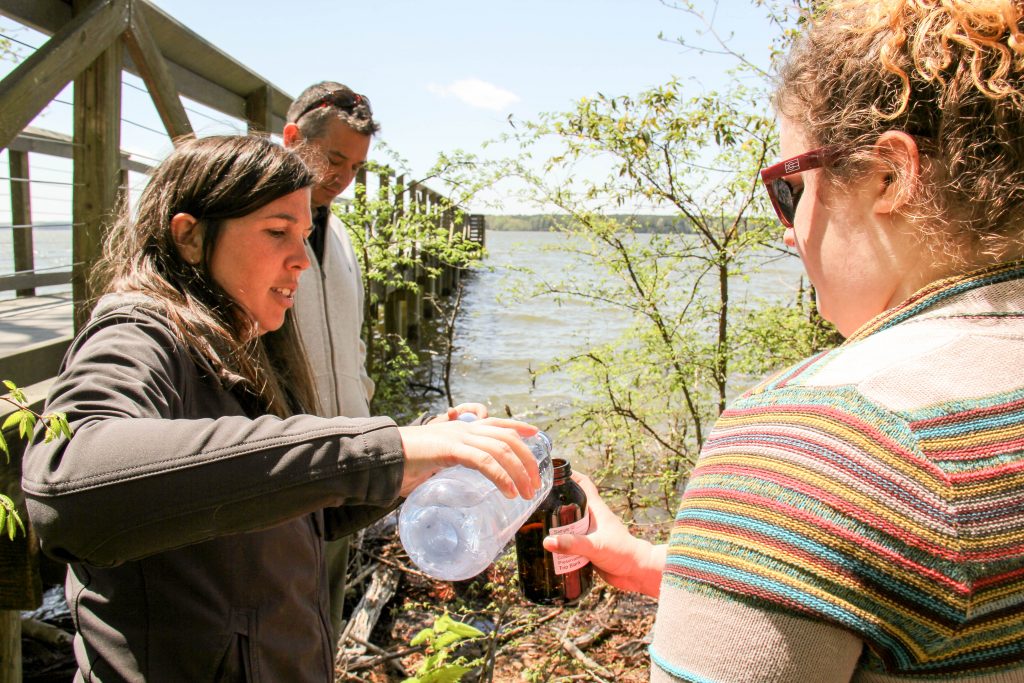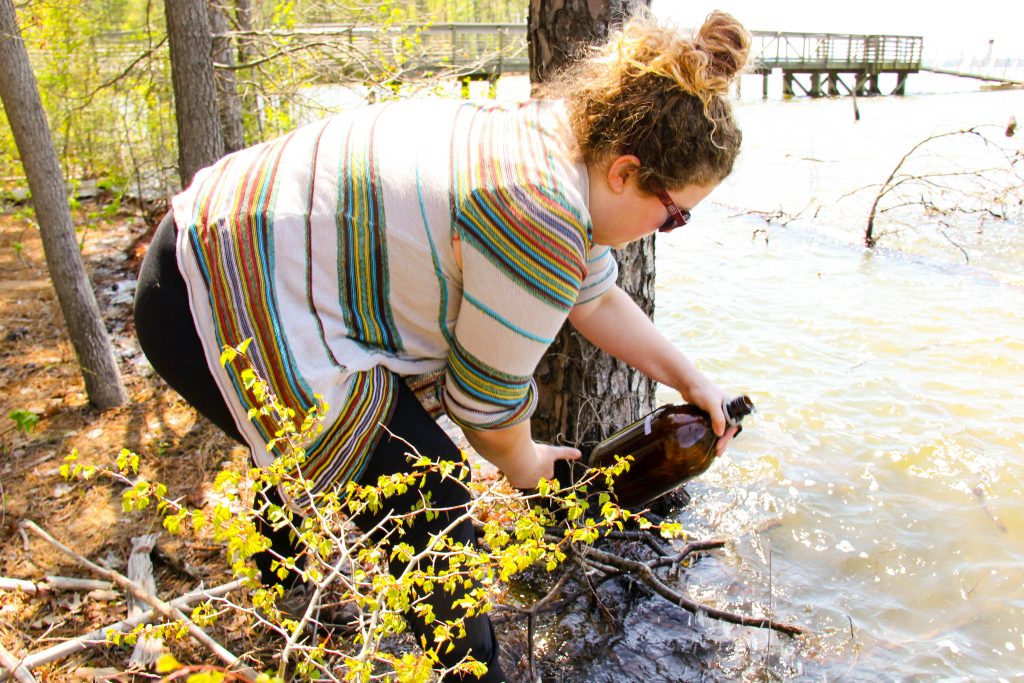By Chrissy Garwood
Chrissy Garwood (left) graduated from UNC in 2018 with a B.A. in Environmental Studies. Garwood and Andrew George, (right) a community engagement research associate at the Institute and lecturer in the Environment, Ecology and Energy Program (E3P).
Defining the Research Question
This spring, I participated in a senior capstone class with students in UNC-Chapel Hill’s Environment, Ecology, and Energy Program (E3P) and led by the Institute for the Environment’s Andrew George. A capstone is an engaged scholarship course that allows students to work with a client on an important research question. We focused on environmental justice, emerging contaminants, and North Carolina’s drinking water with our client, the Haw Riverkeeper and Neuse Riverkeeper, to explore potential contamination in public drinking water systems along the Cape Fear and Neuse Rivers.
There have been multiple cases throughout North Carolina and the United States in which certain disadvantaged communities have been subjected to disproportionate burdens of potentially hazardous chemical contamination. These are called environmental justice (EJ) communities and have a larger percent minority population, low income population, less educated population, or some combination of these indicator variables. Although we focused on a number of specific contaminants and EJ metrics, our research question was put into a somewhat broader context. Can you use these environmental justice metrics to predict an impact from unregulated emerging contaminants in drinking water?
Early in the semester, we met with the Riverkeepers to learn about their interests, explore possible data sources, and develop our research question. With a class of eight students, we could tackle data challenges many non-governmental organizations (NGO’s) and/or local governments don’t have the capacity to address. We spent many hours sifting through a large, little known EPA dataset of emerging unregulated contaminant to analyze variables important to our client. We also had access to GIS, statistical software, and other resources available at the state’s flagship institution. At the same time, we were limited to a semester long project, so it was important we focussed on a research question we could actually answer and provide meaningful results for our client.
Being that this is a hot button issue right now with the emergence of Gen-X throughout NC waterways, in our food, and even in the rain, our class attended several conferences in the Triangle about the convergence of water quality and environmental justice throughout. We traveled to several of these functions to meet and gain insight from North Carolinians who have spent years trying to improve people’s rights and access to clean water. These conversations and real-world examples of affected communities truly strengthened the passion we felt for our project.
Field Work and Data Analysis
In addition to the EJ perspective, we had opportunities to get a more intimate view of the contaminant testing side as well. I got to see the process in action with the Haw Riverkeeper’s Emily Sutton, who demonstrated proper sampling techniques during a trip to check the water at Jordan Lake, including carefully collecting four jugs of water to test just one contaminant. Needless to say, we were happy to have access to an EPA dataset of previous water tests for our study.
For our analysis, we used the EPA’s “Unregulated Contaminant Monitoring Rule” dataset (UCMR3) that included samples taken at every public water system in the state. These samples tested for new and “emerging” contaminants that are unregulated by the federal government, including relatives of “Gen X” (known as PFAS), as well as toxic metals like Hexavalent Chromium, that were found directly in the drinking water consumed by millions of North Carolinians every day. The issue with these new chemicals is that many of their health effects have not been studied, and there is some evidence to suggest relatives of these emerging contaminants, like the recently discontinued DuPont chemical, C8, cause adverse health effects like cancer and developmental complications. In fact, there have been health-bases studies on only 200of the existing 80,000 chemicals released in the environment (Gross & Birnbaum 2018).
After exploring the existing UCMR3 dataset for the 35 water treatment facilities of interest to our client, we gathered EJ demographic data on race, education, income, and linguistic isolation. Census block groups were determined as potential EJ areas if they surpassed the NC state average for at least one of those metrics for which we gathered data. Once all analyses were compiled, the GIS team generated visual representations of each facility and their proximity to possible EJ areas, while the statistics team generated bar graphs to represent the extent of contamination at each of the sites.

Developing Our Findings
Our main finding was that chemical contamination was ubiquitous across the 35 analyzed sites, and the environmental justice indicators were not correlated with any of the 7 chemicals across the sites. Every facility had at least some level of contamination, and several were very high.

Though our results indicated that EJ metrics can’t be used to predict water contamination in the Neuse and Haw river basins, there may be different patterns of disproportionate exposure in other water basins around the state. History serves as a reminder that some areas are more heavily affected by these issues than others, and our thorough literature review suggests that in many other watersheds, our hypothesis may hold true.
We hope that our paper and presentation may inspire others to further investigate this issue in other parts of the state, nation, and world, as it is clear that water contamination is ubiquitous in its distribution, but not always equal in magnitude. In a world where water is a human necessity, but not a human right, it is vitally important to question the origins of such inequity if any steps are to be taken toward progress.
More information about this Capstone project and other UNC environmental capstone projects can be found at https://ie.unc.edu/education/capstone/.


